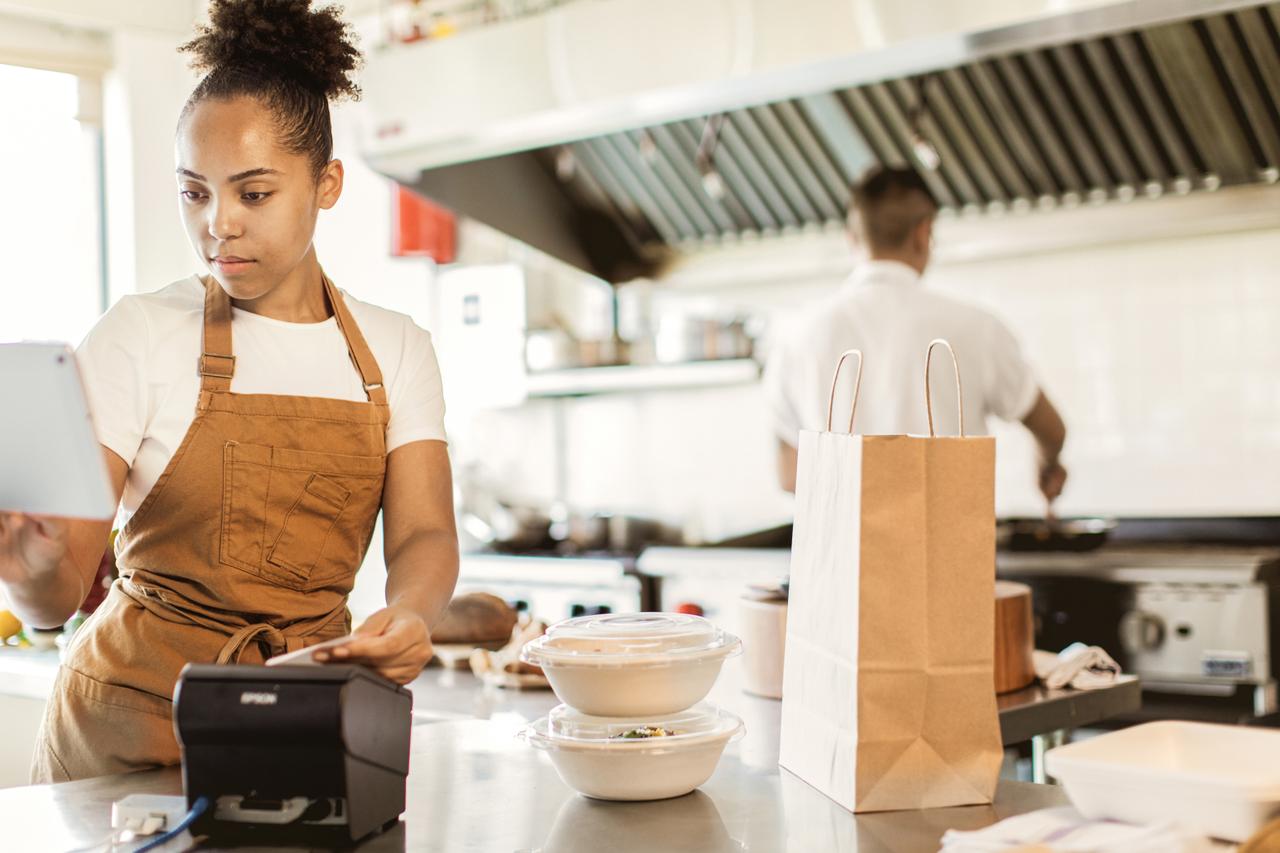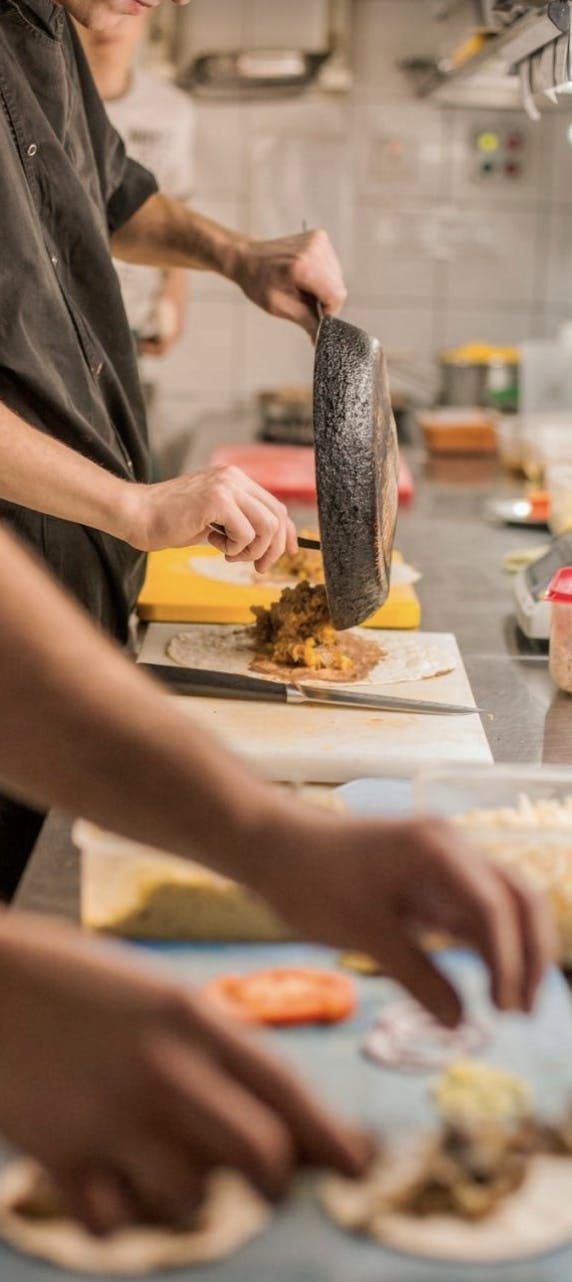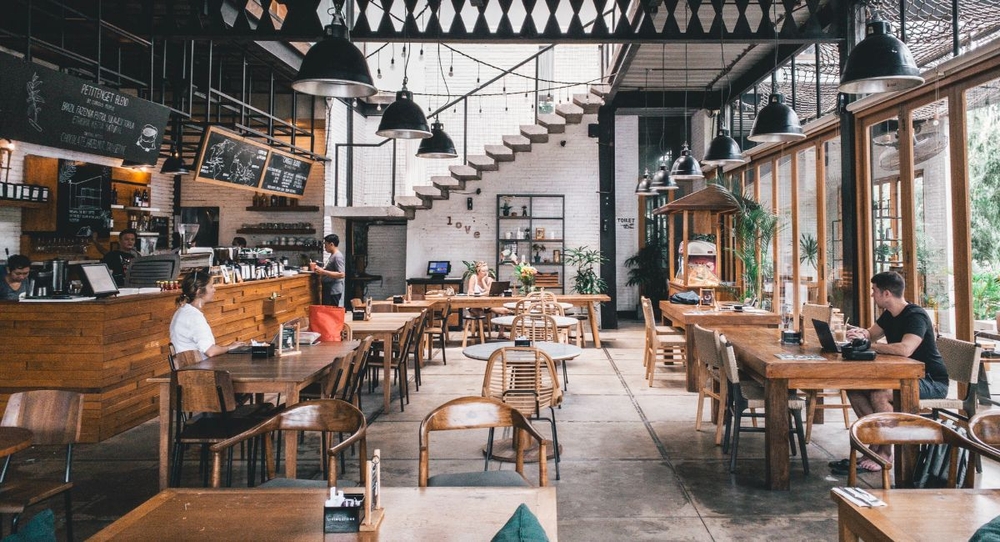How to Read a Restaurant Profit and Loss Statement
Table of Contents
CloudKitchens
How many tacos can be delivered from a 1000sqft restaurant?
The same amount as a 200sqft ghost kitchen.

Here’s the P/L guide you’ve been looking for
You may be looking for new ways to cut costs and grow profit with your restaurant business. Opening a new restaurant is tough, and managing your restaurant’s profit and loss statement (also known as a P&L statement) can be even more difficult.
But you’re not alone. Many restaurateurs are struggling with their P&L statements, that’s why we’re here to help.
Research shows that 50% of new restaurants go out of business by their fifth year of operation, due to the inability to make a profit.1
Now’s the time to master your profit and loss statement, so you can better manage your expenses and start growing your margin.
But what is a profit and loss statement exactly? And how do you read it?
We’re breaking down each section of a profit and loss statement from start to finish, so you can build a thriving restaurant business.
Let��’s start with the fundamentals, so you can better understand what a P&L statement entails.
What is a profit and loss statement?
A restaurant profit and loss statement measures the revenue and expenses generated by a restaurant over a specified period of time. This essential financial statement works as a source of truth as to whether a restaurant is generating profits or operating at a loss.
There are three primary sections of a P&L. Here’s a quick breakdown of each:
Section 1
The initial section of the P&L will include a breakdown of sales and revenue. This is where you’ll list out your total sales and revenue, whether that be from food, alcohol, or other services you may offer at your restaurant.
Section 2
The second section of the P&L section is where you’ll list your cost of goods sold (also known as COGS). We’ll dive into everything you need to calculate this in the next section below.
Section 3
The final section of your P&L will include total operating expenses and employee salary and benefits. These can include items such as the cost of restaurant insurance and occupancy expenditures.
Curious about what the primary terms are and what they represent in your profit and loss statement? We’re breaking down each key term so you can master your P&L.
Key terms and phrases in each section of the profit and loss statement
1. Sales/Revenue
First, there’s sales and revenue, which sounds pretty straightforward. But what are the primary categories that fit into sales and revenue?
This section can be split into food, catering, alcoholic and non-alcoholic beverages, and merchandise, to name a few.
It is crucial to make this section as detailed as possible, narrowing down the total sales and revenue for each category that makes up your restaurant business.
If you also offer catering services for special events, you’ll want to incorporate this into a separate section of your profit and loss statement.
2. Cost of Goods Sold (COGS)
Next, it’s time to incorporate your cost of goods sold, also known as COGS. Your Cost of Goods Sold is your cost of purchasing raw ingredients. Think of this as how much you spend on your food and beverage inventory to fulfill your incoming orders.
You begin calculating this by taking your beginning food and beverage inventory that you started with and adding the purchases you made.
Here’s how to calculate your cost of goods sold:
| Cost of Goods Sold (COGS) = Beginning Inventory + Purchases – Ending inventory |
Let’s say you start this month off with $1,500 left in your food and beverage inventory and during this month you spend about $2,000 on additional food and beverage, ending the month with $800 left of inventory.
In order to calculate your cost of goods sold, you would first take your $1,500 worth of inventory that you began the month with, add the additional $2,000 in inventory you purchased, and subtract your ending inventory of $800.
Did you get $2,700? That’s your cost of goods sold.
This simple calculation is vital for understanding how much you’re spending on your food and beverage, spices, condiments, and everything else you need to prepare each menu item.
It’s recommended that your cost of goods sold remain at 31% percent of your sales or below, to ensure your expenses don’t end up higher than your revenue.2
Once you’ve calculated your cost of goods sold, you can take this value and use it to calculate your gross profit.
3. Gross profit
You’ll also need to calculate your restaurant profit margin. Your gross profit is the amount remaining after you take out your cost of goods sold from your total sales.
Here’s how you calculate your gross profit:
| Gross Profit = Total Sales Revenue – Cost of Goods Sold (COGS) |
This calculation will show you how profitable your restaurant business is. You’re able to gauge how effectively you’re using your raw ingredients and staff to fulfill each order.
However, the cost of goods sold is not the only cost you need to take into account when developing your profit and loss statement. You’ll also need to factor in the cost of labor.
4. Restaurant labor costs
The next section of your profit and loss statement is restaurant labor costs. Your labor costs start with any wages paid to your employees, plus any costs incurred with payroll and benefits. This includes payroll taxes, PTO and sick pay, workers’ compensation, health insurance, and any employee meals you offer.
Many restaurateurs find labor to be the highest cost incurred as part of their business. It’s vital to determine the number of front-of-house and back-of-house employees needed to operate at maximum efficiency.
Paying close attention to your restaurant labor costs can help you determine where to save money, and if an investment in any labor-saving equipment would be necessary to cut additional costs.
Once you’ve determined your labor costs, you’ll want to list out your direct operating expenses.
5. Direct operating expenses
Your direct operating expenses are any supplies and equipment as well as services that you use for daily operations. This includes kitchenware, dinnerware, any cleaning supplies, and services as well as WiFi.
In addition to the direct operating expenses, you’ll also be taking into account the marketing expenses that you have.
6. Utilities
Your utilities include any energy sources you need to run your restaurant business. This includes everything from gas, water, electricity, waste removal, and recycling.
7. Marketing expenses
Any expenses that are allocated towards promoting your restaurant are considered marketing expenses. This includes any promotions you’re running, ads, and discounts offered.
Your marketing expenses can come from any platform. For instance, any delivery app that you’re running a promotion on will be attributed to your marketing expenses. These expenses will vary depending on which delivery apps you’re working with and the marketing fees that come with each.
There are also paid advertisements you could be running on social media, the web, any email marketing you’re implementing, and even SMS text message campaigns.
Your total marketing expenses can vary depending on where you are marketing your business and the costs of promotions depending on the platform you’re using.
Next, you’ll need to factor in your general and administrative expenses.
9. General and administrative expenses
When determining your general and administrative expenses, you’ll review any expenses that are needed to run the financial side of your business.
This includes credit card processing fees that come with each order you fulfill as well as payroll processing fees, travel expenses, business taxes, and license fees.
9. Repair & Maintenance (R&M)
Your repair and maintenance include any labor and materials needed in order to keep your physical restaurant space up to code and safe for operation. Think of this as any costs that go into the maintenance of your restaurant, such as structural fixes and decor.
This section of your profit and loss statement can change dramatically depending on any unforeseen repairs needed. That’s why it’s crucial that you’re always prepared for any potential repair and maintenance expenses that may come up.
This can be anything from new commercial kitchen equipment needed or building repairs. Repair and maintenance expenses can be large or small, depending on the level of upkeep needed. It can be as small as fixing a leaky pipe or updating a whole new set of equipment.
Depending on your brick-and-mortar location and the type of lease you have, you may be stuck with most of the expenses as opposed to your landlord incurring most of the expenses.
Overall, this is a section of your profit and loss statement that you’ll want to keep a close eye on to monitor any hefty upcoming expenses that you can better prepare for.
10. Occupancy
Occupancy consists of the costs associated with occupying your brick-and-mortar location. This is typically one of the most costly sections of your P&L, including your rent, storage, personal property tax, depreciation, and amortization.
Consider occupancy the nuts and bolts of your restaurant business. It’s your primary fixed costs, which are costs that remain constant.
11. Net profit
Last but not least, you’ll need to calculate your net profit. This is the money you take home after all the expenses we’ve reviewed are paid for.
Your net profit is typically between 2 to 6%, depending on your level of expenses in respect to your total revenue.
To calculate your net profit, you’ll simply take your total sales revenue and subtract your total expenses.
Here’s the quick calculation for net profit:
| Net Profit = Total Sales Revenue – Total Expenses |
That’s the final section you need to know how to calculate, now you’re ready to take on your own P&L statement. We’ve even included a profit and loss statement template here that you can get started with.
Now that you’ve mastered how to read your profit and loss statement, we’re diving into the different types of leases that your brick-and-mortar location can have and how it can affect the expenses you incur.
Key terms and phrases in each section of the profit and loss statement
The type of lease you have at your restaurant will directly affect your profit and loss statement. Each type of lease varies greatly depending on a number of factors, which in turn will affect what your profit and loss statement will look like.
When you’re searching for restaurants for lease, you’ll need to be aware of the different types of leases that are available to determine which best suits your business needs.
First, let’s start with the different types of landlords you may have at your brick-and-mortar location. There are institutional landlords and mom-and-pop landlords. Here are the key differences between the two so you can better understand which landlord you may have and even further, which type of lease options you have.
You’ll likely be able to tell if you have an institutional landlord, given they usually are associated with larger corporations that typically develop and sell real estate quickly.
On the other hand, there are mom-and-pop landlords that usually have smaller portfolios and are family-owned. They usually retain assets for much longer periods of time and don’t sell quickly like an institutional landlord.
Now that we’ve outlined the two different types of landlords, we’re diving into the different types of leases that you can have at your brick-and-mortar location.
Gross lease
The first type of lease is a gross lease. This is the most common type of lease that a mom-and-pop landlord will offer you for your restaurant business. This type of lease is an agreement based on an annual price per square foot.
This means that your rental agreement for your brick-and-mortar space depends on the size and square footage of your restaurant.
Triple net lease
Next, there’s also a triple net lease, which is the most common lease you’ll have with an institutional landlord. If you have a triple-net lease, you’re responsible for all the finances of your restaurant. You’re essentially operating with a lease as if you owned your restaurant yourself and are not a tenant.
Your lease is also on a price per square foot basis but in addition to this, you’re also responsible for property taxes, insurance, repairs, and common area maintenance (CAM).
Common area maintenance is the shared cost of utilities you’d have within the common areas of your restaurant location. Any utility costs that are shared are prorated under a triple net lease monthly.
Next, we’ll review the final type of lease that you may encounter when opening a new brick-and-mortar location for your restaurant.
Percentage lease
A percentage lease is less common and is usually associated with an institutional landlord. This is a lease typically found in bustling areas such as food halls and airports, as well as shopping malls.
It can sometimes be cheaper, but alternative with expenses occurring monthly. However, if you have this lease, if you reach a certain threshold in sales, you’ll likely end up owing the landlord a small percentage of your gross revenue.
A percentage lease can also come with tenant improvements, which result in paying a fee based on gross sales. It’s important to keep an eye on tenant improvements, as sometimes these can result in more money out of your pocket for improvements to the building your restaurant is located in.
Whether you’re set up with a triple net lease, gross lease, or percentage lease, you’ll be responsible for paying all of your utilities. This is a substantial amount that will be taken from your operating budget.
It’s important to understand the type of landlord you have and the type of lease your restaurant has, so you can make better decisions about your expenses, and build your business for success.
As you’re reviewing your P&L, it might be worth crunching some numbers for opening a ghost kitchen or virtual kitchen instead of a traditional restaurant. You may be surprised at how much better your margins look with CloudKitchens, rather than brick and mortar. We’re laying out the key differences so you can see how we stack up to a traditional brick-and-mortar restaurant.
CloudKitchens vs. brick-and-mortar, what’s the difference?
Less risk
With CloudKitchens, you’re set up in a delivery-only kitchen optimized for delivery. Unlike a traditional brick-and-mortar restaurant, you’re not responsible for building maintenance and repairs.
You’re also not in charge of your common area upgrades. When you’re operating out of a ghost kitchen, you’re only paying for your kitchen, there are no additional fees for common areas or additional fees like property taxes and building-level maintenance.
At CloudKitchens, we’ll handle most key services like cleaning your kitchen hood, whereas you’d typically be handling this cost yourself in a traditional brick-and-mortar. This means you can save up to 40% in expenses when you’re operating out of a ghost kitchen.
With our support, you’ll have less financial risk and expenses, while growing your restaurant business with higher return.
We’ll handle the nitty gritty, so you can get back to doing what you love: cooking great food for happy customers.
Fewer headaches
There’s also less of a headache with a ghost kitchen as opposed to your standard brick-and-mortar restaurant. With CloudKitchens, you no longer need to worry about large repair and maintenance fees. If something in your kitchen breaks, we’ll fix it. It’s at no extra cost to you.
In a traditional brick-and-mortar, maintenance is typically 1-2% of your operating budget. At CloudKitchens, we’ll take care of the maintenance and work with third-party vendors so you’re back to business.
We’ll also handle the cleaning, logistics, and fulfillment so there’s more taken off your plate. All you have to do is fire up those grills.
Lower cost
Last but certainly not least, you’re running your business out of a ghost kitchen that’s a fraction of the cost of brick-and-mortar. Not only are you eliminating unnecessary expenses, but you’re also decreasing your overhead and increasing profit.
You’re only offering restaurant delivery services, which means you typically only need 3 to 5 employees. We supply the order runners, order handoff staff, and more.
Opening a restaurant is easier than you think, especially when you have our support. Ready to finalize your restaurant business plan and start growing your restaurant business?
Ready to open a restaurant? Tour a CloudKitchens facility today!
Whether you are searching for a ghost kitchen in Philadelphia, Chicago, or a ghost kitchen in Tempe, we can help provide the best facility near you. Contact us today!
| DISCLAIMER: This information is provided for general informational purposes only and the content does not constitute an endorsement. CloudKitchens does not warrant the accuracy or completeness of any information, text, images/graphics, links, or other content contained within the blog content. We recommend that you consult with financial, legal, and business professionals for advice specific to your situation. |
Sources:
Book Keeping Chef. Restaurant Profit and Loss Statements. https://bookkeepingchef.com/restaurant-profit-and-loss-statements-understanding-and-creating-them/
Small Business. Controlling COGS in Restaurants. https://smallbusiness.chron.com/control-cogs-restaurants-35782.html
More insights & stories
There’s more where that came from.
Get in the know and check out our additional insights



